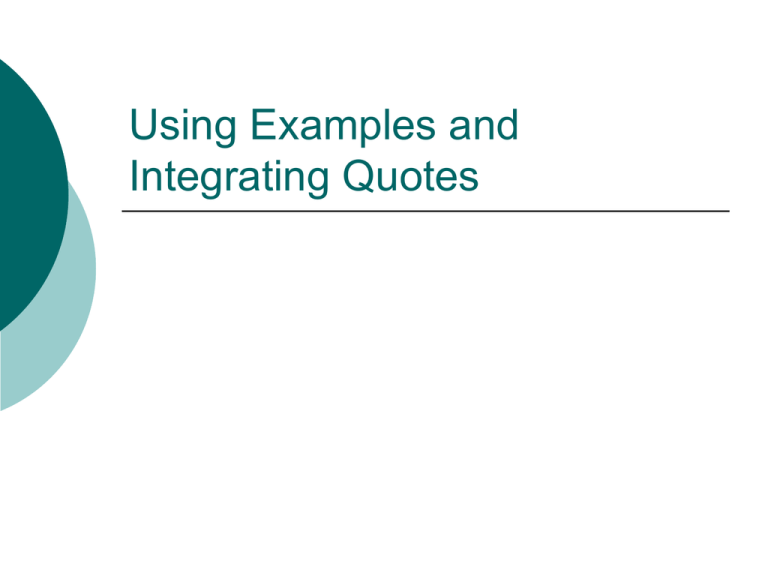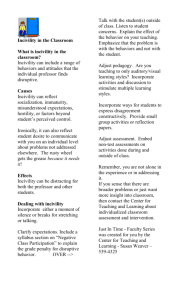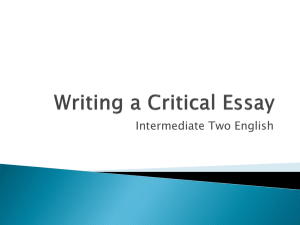File
advertisement

Using Examples and Integrating Quotes Summary, Paraphrase, and Quotations No matter what method you use to integrate other people’s words and ideas into your own essay, always be sure to document your sources. Summary To summarize means to condense what someone else has said and put it into your own words. Paraphrase To paraphrase means to restate someone else’s ideas in your own language and in about the same number of words. Quotations Using quotations means bringing someone else’s exact words into your essay. But how do I integrate my sources into my argument? It’s not enough simply to plop quotes or ideas from other sources into your own work; instead you must weave them in in a way that helps your readers understand exactly why you’ve done so. Where does this quote/reference come from? What point does it prove or support? The Three Step Program Once you’ve found the evidence, quotes, materials you want to incorporate into your essay, follow these three steps to using examples effectively. Preview 1) Give your readers an indication (or preview) of what’s coming. Ex. But not everyone agrees that public incivility is inherently bad. Present 2) Go on to provide a specific example or quote that illustrates the point you just made. For example, Brian McGee points out that “incivility encourages uncommitted voters and media organizations to pay attention” (556). Credential the Source When appropriate, use a signal phrase to introduce your evidence—and to show your reader why this source can be trusted. Who’s he? For example, Brian McGee, a communications scholar and department chair at the College of Charleston in South Carolina, points out that “incivility encourages uncommitted voters and media organizations to pay attention” (556). Follow Through Then, follow through with your interpretation of the quote or reference you just made. Explain the point you want your readers to take from the evidence you just provided. Public ranting and unconventional behavior, in other words, can be important instruments of political change. So what does this look like all together? 1) Preview (of main idea being developed) 2) Present (signal phrase + quote or evidence) 3) Follow through (interpretation) The whole sh’bang. . . But not everyone agrees that public incivility is inherently bad. For example, Brian McGee, a communications scholar and department chair at the College of Charleston in South Carolina, points out that “incivility encourages uncommitted voters and media organizations to pay attention” (556). Public ranting and unconventional behavior, in other words, can be important instruments of political change. But what’s a signal phrase? A signal phrase, which typically comes at the beginning of the sentence, literally signals to your reader what’s to come in the text. It is the place where you introduce and attribute your sources. So what do signal phrases look like? They typically include the author’s name and/or the title of the source, along with a verb or verb phrase that indicates how the quote or evidence that follows fits in to your argument. Ex. In his essay, “Can Political Rhetoric Be Too Civil?” Brian McGee argues that. . . Credentialing your sources Really effective signal phrases will often include some additional information about the author as well. These signal phrases “credential the source” and allow you to demonstrate your own ethos as a writer. In his essay, “Can Political Rhetoric Be Too Civil?”, Brian McGee, a communications scholar and department chair at the College of Charleston in South Carolina, points out that “incivility encourages uncommitted voters and media organizations to pay attention” (556). Use powerful verbs to introduce your sources (see your textbooks to find lists like this!) acknowledge add admit advise agree allow analyze argue ask assert believe charge claim comment compare complain concede conclude contend criticize declare disagree discuss dispute emphasize explain express find grant illustrate imply insist interpret maintain note object observe point out refute reject remark reply report respond show state suggest write Do I have to do this every time? Yes, it’s a good idea to get in the habit of doing so. These interpretations and explanations, after all, are where you develop your argument. In these follow through statements, you’re interpreting evidence and explaining how it supports the claim to which you’ve tied it. What about Factual Evidence? Do I have to interpret that, too? In a word, YES! You should never assume that your readers will see things the way you do or the way you intend for them to. Instead, cut the risk (and lengthen your essay) by following through every time and spelling out the important conclusions you’ve drawn from your careful study of this evidence.











